We are shocked by the rise of many prices, especially food. Fortunately, we mute the cost by finding or growing groceries here at Winding Pathways. We’re lucky to own two acres, but folks living on tiny lots can produce an amazing amount of food, even if they aren’t passionate gardeners.
In a nutshell here’s what we do to tame grocery bills:
Foraging
It’s ironic that many people consider the most delicious and easy wild foods pests and spend time and money trying to eliminate them. We eat ‘em. Books and websites, including Winding Pathways, share tips on finding, identifying, harvesting, cooking, and eating wild foods. Caveat: ALWAYS check that you have the correct plant, gather from unpolluted places, and consume only a small amount initially to be sure your body accepts the wild edible.
Here are our favorites:
-
- A springtime bonanza of vitamins and minerals awaits with each bite of cooked nettles.
- A full pot of raw Lamb’s Quarters cooks down to a few fork fulls of this nutritious potherb.
- The white meat of an acorn.
- Panfish are easy to catch, clean, and eat.
Mid to late spring: Nettles and dandelions.
- Late spring through summer: Lambs quarters, purslane, amaranth, and the bluegills and crappies we catch.
- Early fall: Acorns, new lambs quarter growth, and walnuts. Watch this YouTube video for complete processing and eating the cookies!
- Winter: Venison from the deer we harvest…..if we’re lucky.
Gardening
We’re not passionate gardeners and we don’t can or freeze vegetables, so here’s what we do:
- Succession plant: Our small garden yields an enormous amount of food. We don’t let a square foot be idle. When summer’s heat turns lettuce bitter, we pull it, feed it to our chickens, and plant beans or another heat-loving crop. Same with other crops that grow quickly and then fade.
- Use vertical space: Pole beans, for example, produce much more food per square foot than bush beans, so we choose climbers and use vertical space. We have the pole high enough to reach up and pull off the beans.
- Grow dwarfs: Some cucumber varieties, for example, are “bush” type, meaning they produce a crop without long vines that consume plenty of space.
- Think of winter eating: Because we lack freezer space and don’t can food, we plant vegetables that need little care during the growing season and store them until late winter without being canned or frozen. Here’s our list:
-
- Winter squash. Pick them, let them curet, and store them in a cool spot. They keep for months. Same with pie pumpkins.
- Carrots and parsnips. In late fall we smother the plants with a thick blanket of dry leaves or straw that keeps the ground from freezing. We’ve harvested carrots in January by brushing away snow and peeling back the mulch and pulling them.
- Sweet potatoes. They love the South’s climate yet grow well up north.
We carefully dig them in the fall, cure them, and store them like winter squash.
- Sweet potatoes are a healthy vegetable.
- Winter Squash vary in color, texture, shape and size.
Chickens
We can’t imagine living without a small chicken flock. Our six to 12 hens gift us a couple of dozen eggs a week. Their manure fertilizes the garden and garden weeds are a great hen chow. During warm months our hens forage in their large run eating bugs, worms, and weeds and transforming them into eggs. Sometimes we even stew down an old hen.
- In the summer hens find plenty to eat.
- The chickens kept on laying eggs.
- Chickens efficiently recycle squash seeds to eggs.
Wildlife
Lots of folks don’t like hunting. For us harvesting a deer is a form of food gathering, not recreation. After all, deer are free-ranging, local, and organic. Fortunately, we’re able to hunt on our property and convert a deer into delicious meat. We also enjoy eating panfish.
Like most folks, we can’t grow or forage all our food but much comes from the yard and area. It takes knowledge and investment in elbow grease but trims the food budget. Perhaps even better, knowing how to find and grow food makes us feel less vulnerable to national disruptions that make food either hard to get or expensive.

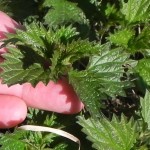
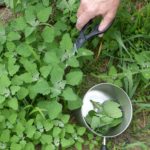
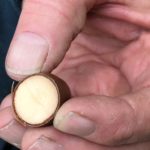

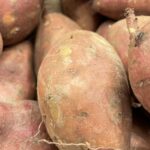
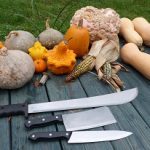
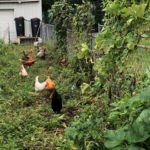
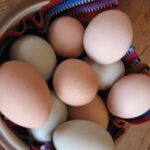
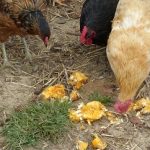

As a child I remember our Mom showing us how to harvest dandelions and milkweed so we could have greens for supper. I cringe today when people refer to them as weeds and do everything in their power to eliminate them. Of course, your spouse has to appreciate the nutritional value of the aforementioned.(:
Thanks for reminding us that many plants are there to help people not kill and support the chemical companies. Anyone of European descent (and we are ALL immigrants) would do well to thank our ancestors for introducing dandelions as they grow early in the season thus providing us with vitamins scarce in the winter months. As you know, the native plant, milkweed, is valuable to monarchs and other insects. It is edible early in the season – the tender green shoots, later the blooms before they open, and the pods. As always use caution, if you see monarch caterpillars on any leave the plant alone. The monarchs were “there first.” A credible reference is https://foragerchef.com/guide-to-milkweed/